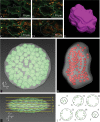Unbiased estimation of chloroplast number in mesophyll cells: advantage of a genuine three-dimensional approach
- PMID: 24336344
- PMCID: PMC3904715
- DOI: 10.1093/jxb/ert407
Unbiased estimation of chloroplast number in mesophyll cells: advantage of a genuine three-dimensional approach
Abstract
Chloroplast number per cell is a frequently examined quantitative anatomical parameter, often estimated by counting chloroplast profiles in two-dimensional (2D) sections of mesophyll cells. However, a mesophyll cell is a three-dimensional (3D) structure and this has to be taken into account when quantifying its internal structure. We compared 2D and 3D approaches to chloroplast counting from different points of view: (i) in practical measurements of mesophyll cells of Norway spruce needles, (ii) in a 3D model of a mesophyll cell with chloroplasts, and (iii) using a theoretical analysis. We applied, for the first time, the stereological method of an optical disector based on counting chloroplasts in stacks of spruce needle optical cross-sections acquired by confocal laser-scanning microscopy. This estimate was compared with counting chloroplast profiles in 2D sections from the same stacks of sections. Comparing practical measurements of mesophyll cells, calculations performed in a 3D model of a cell with chloroplasts as well as a theoretical analysis showed that the 2D approach yielded biased results, while the underestimation could be up to 10-fold. We proved that the frequently used method for counting chloroplasts in a mesophyll cell by counting their profiles in 2D sections did not give correct results. We concluded that the present disector method can be efficiently used for unbiased estimation of chloroplast number per mesophyll cell. This should be the method of choice, especially in coniferous needles and leaves with mesophyll cells with lignified cell walls where maceration methods are difficult or impossible to use.
Keywords: Chloroplast counting; Norway spruce (Picea abies L. Karst.); confocal microscopy; coniferous needle structure; disector method; mesophyll; profile counting; stereology..
Figures






Similar articles
-
Novel efficient methods for measuring mesophyll anatomical characteristics from fresh thick sections using stereology and confocal microscopy: application on acid rain-treated Norway spruce needles.J Exp Bot. 2007;58(6):1451-61. doi: 10.1093/jxb/erm007. Epub 2007 Feb 24. J Exp Bot. 2007. PMID: 17322549
-
Cell and chloroplast anatomical features are poorly estimated from 2D cross-sections.New Phytol. 2020 Mar;225(6):2567-2578. doi: 10.1111/nph.16219. Epub 2019 Nov 12. New Phytol. 2020. PMID: 31553810
-
Seasonal movement of chloroplasts in mesophyll cells of two Picea species.Protoplasma. 2020 Jan;257(1):183-195. doi: 10.1007/s00709-019-01427-6. Epub 2019 Aug 13. Protoplasma. 2020. PMID: 31410588
-
Differential positioning of chloroplasts in C4 mesophyll and bundle sheath cells.Plant Signal Behav. 2011 Aug;6(8):1111-3. doi: 10.4161/psb.6.8.15809. Epub 2011 Aug 1. Plant Signal Behav. 2011. PMID: 21757999 Free PMC article. Review.
-
Critical review: incorporating the arrangement of mitochondria and chloroplasts into models of photosynthesis and carbon isotope discrimination.Photosynth Res. 2019 Jul;141(1):5-31. doi: 10.1007/s11120-019-00635-8. Epub 2019 Apr 6. Photosynth Res. 2019. PMID: 30955143 Review.
Cited by
-
Comparative sequence and methylation analysis of chloroplast and amyloplast genomes from rice.Plant Mol Biol. 2019 May;100(1-2):33-46. doi: 10.1007/s11103-019-00841-x. Epub 2019 Feb 20. Plant Mol Biol. 2019. PMID: 30788769
-
Effects of Salinity Stress on Chloroplast Structure and Function.Cells. 2021 Aug 7;10(8):2023. doi: 10.3390/cells10082023. Cells. 2021. PMID: 34440792 Free PMC article. Review.
-
The Evolution of Per-cell Organelle Number.Front Cell Dev Biol. 2016 Aug 18;4:85. doi: 10.3389/fcell.2016.00085. eCollection 2016. Front Cell Dev Biol. 2016. PMID: 27588285 Free PMC article. Review.
-
Structure, function, and assembly of PSI in thylakoid membranes of vascular plants.Plant Cell. 2024 Oct 3;36(10):4080-4108. doi: 10.1093/plcell/koae169. Plant Cell. 2024. PMID: 38848316 Free PMC article. Review.
-
DeepD&Cchl: an AI tool for automated 3D single-cell chloroplast detection, counting, and cell type clustering.Front Plant Sci. 2025 May 23;16:1513953. doi: 10.3389/fpls.2025.1513953. eCollection 2025. Front Plant Sci. 2025. PMID: 40487218 Free PMC article.
References
-
- Adachi S, Nakae T, Uchida M, et al. 2013. The mesophyll anatomy enhancing CO2 diffusion is a key trait for improving rice photosynthesis. Journal of Experimental Botany 64, 1061–1072 - PubMed
-
- Albrechtová J, Kubínová L. 1991. Quantitative analysis of the structure of etiolated barley leaf using stereological methods. Journal of Experimental Botany 42, 1311–1314
-
- Albrechtová J, Janáček J, Lhotáková Z, Radochová B, Kubínová L. 2007. Novel efficient methods for measuring mesophyll anatomical characteristics from fresh thick sections using stereology and confocal microscopy: application on acid rain-treated Norway spruce needles. Journal of Experimental Botany 58, 1451–1461 - PubMed
-
- Bockers M, Čapková V, Tichá I, Schafer C. 1997. Growth at high CO2 affects the chloroplast number but not the photosynthetic efficiency of photoautotrophic Marchantia polymorpha culture cells. Plant Cell Tissue and Organ Culture 48, 103–110
Publication types
MeSH terms
LinkOut - more resources
Full Text Sources
Other Literature Sources

